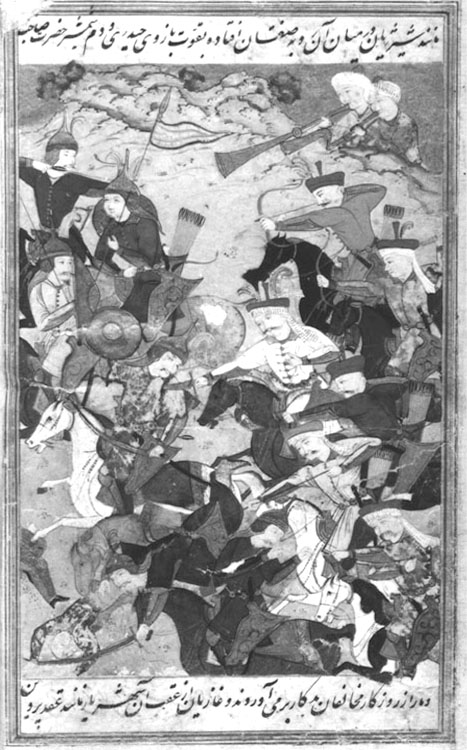Date of this event: 908/1503.
Sultan Morād, the son of Yaʿqub Pādešāh, was the ruler of Fars, Persian Iraq, Kerman, and Khuzestan. Together, he and Mirzā Alvand Torkman, had divided the Aq Qoyunlu empire between them. When Morād heard of Esmāʿil’s victory over Alvand (907/1500), he mobilized his forces intending to achieve independent status. Hearing of Morād’s movements, Esmāʿil dispatched an envoy named Qanbar Āqā, a trusted servant of Esmāʿil’s father Ḥeydar, who offered Morād friendship in turn for submission. Morād refused, and on Saturday, 24 ¸Ẕuʾl-ḥejja 908/21 June 1503 a great battle took place at Ālma Bolāǧi, near Hamadan. Eskandar Monshi reports that Morād had 70,000 troops, while Esmāʿil had only 12,000 qezelbāš. Nevertheless, the accompanying text states that Esmāʿil, like a ferocious lion, charged into the midst of the enemy, and with the energy of the forearm of Sultan Ḥeydar and the sword of the twelfth imam, he and his ǧāzi’s destroyed the opposition. Curiously, Monshi coins a similar phrase: “Esmāʿil, by virtue of Ḥeydar’s strong right arm, ... shattered the Turkman forces”. While the terms forearm or strong right arm of Ḥeydar is a euphanism for the strength of God, in this context it may also bespeak of the assistance rendered by Qanbar Āqā, the trusted servant of Sultan Ḥeydar. Although his forces were defeated, Sultan Morād escaped to Shiraz to reconsolidate his position.
The battle at Ālma Bolāǧi is depicted as a foray between two opposing groups, set against a hillside that rises to a craggy ridge, and the sky beyond. Fifteen figures and twelve horses are shown. On the right is Esmāʿil, accompanied by five ǧāzis and two trumpeters; on the left are seven of Morād’s Turkmen. The fighting is fierce: Esmāʿil is in the vanguard thrusting his sword through an opponent, while three qezelbāš around him are firing arrows. Another qezelbāš of high rank, in the foreground, has speared an opponent and dislodged him from the saddle. And in the lower right, the remaining ǧāzi has lassoed his prey around the neck. Only two of the Turkman forces remain unscathed - an archer in the upper left, and a standard bearer who rides steadfastly onward.
Painting: 17.5 x 12.2 cm. Frame encloses painting and text. Painting worn and flaked in several places; upper left corner of the frame is missing. No apparent signs of retouching. Not signed or dated.
Painting references:
Unpublished.
Text X-references:
See Savory, SA_1979, p.45-46 for this event in the History of Shah ʿĀbbās.
Robert Eng
Last updated: November 22, 2010
